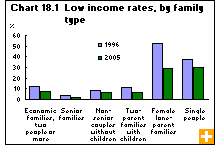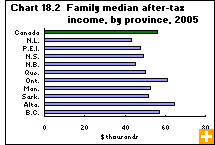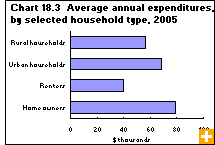Common menu bar links
Income, pensions, spending and wealth
Archived Content
Information identified as archived is provided for reference, research or recordkeeping purposes. It is not subject to the Government of Canada Web Standards and has not been altered or updated since it was archived. Please contact us to request a format other than those available.
The last decade of strong economic growth has benefited most Canadian families. Incomes have grown, while pensions, savings and retirement plans have grown strongly. Bigger incomes have enabled families to spend more and accrue wealth. By 2006, Canadians’ wealth was at a near-record high.
Canada has many types of families, and each makes a living in a different way. In 2005, two-parent families with children had the highest median market income, at $72,800—market income is earnings from employment, investments and private pensions. But they also paid the most in taxes and received modest government transfers, bringing their median after-tax income to $65,700.
Single people had the lowest median market income, at $18,100. Female lone-parent families had low incomes on average, but they received significant government transfers, so their median after-tax income was $30,400.
Senior families made little by way of market income in 2005; however, their median government transfers totalled $22,000, and they paid lower taxes. So senior families collected a median $40,400 in after-tax income in 2005.
Median after-tax income for all families with two or more people rose 1.6% from 2004 to $56,000, after adjusting for inflation. This gain in after-tax income came on the heels of a 1.3% gain in 2004 as strong economic growth created jobs and boosted earnings.
Proportion with low income has fallen considerably
Thanks to economic conditions over the past decade, the percentage of Canadians below the low-income cutoff rate—the threshold below which a larger share of income than average is devoted to the necessities of food, shelter and clothing—has decreased considerably. Among all family types, the proportion fell from a high of 12.1% in 1996 to 7.4% in 2005.
From 1996 to 2005, the percentage of female lone-parent families living in low income dropped from 52.7% to 29.1%, partly because more lone parents are earning income. The share of seniors with low income hit a low of 1.6% in 2005. Also, the proportion of children aged 18 and younger living in low-income families stood at 11.7%, down from a peak of 18.6% in 1996.
Income levels vary widely by province
Income levels vary widely from province to province. In 2005, for the second consecutive year, economic families of two or more people in Alberta had the highest median market income in the country, at $70,300. Ontario families were next, at $63,600. Only Alberta and Ontario families had median market incomes above the national median of $57,700 in 2005.
In Atlantic Canada, families’ median market incomes ranged between $36,900 in Newfoundland and Labrador and $49,100 in Nova Scotia. In Quebec, families earned a median market income of $50,100.
Households have been spending more
With wallets generally getting fatter over the past five years, Canadian households have increased their spending as well. In 2000, households spent an average of $55,614 on food, shelter, clothing, transportation, taxes and other things; by 2005, this total had climbed to $66,857.
Where you live helps determine how much you spend—rural households spent an average $12,210 less than urban ones in 2005. Home ownership also affects household spending—annual expenditures of homeowners are almost double those of renters. Also, couples with children spend far more than single people.
Of the average $66,857 in household spending in 2005, about 20% went to taxes at the federal, provincial and municipal levels. Most of the rest was spent on shelter and household operation (23%), transportation (14%) and food (11%). Other components of after-tax household spending included recreation (6%), tobacco products and alcoholic beverages (2%), and personal care (2%).
Personal insurance and retirement plans are also major expenditures for most Canadian families. Among those who regularly set aside money for the future, the average in 2005 was $3,921.
Households spend money partly according to how much they earn. For example, among the richest fifth of Canadian households, 29% of their budget went to taxes and 15% to shelter costs. By contrast, among the poorest fifth of households, less than 4% went to taxes, but 30% was spent on shelter. As a proportion of the total household budget, the poorest families also spent more than twice as much as the richest families on food. Clothing and transportation took up roughly equal proportions among all income groups.
Assets and debts have both increased
Some household spending is entirely consumed or used, such as money spent on food, fuel or recreational activities. A considerable amount also goes toward building equity in property and accumulating financial or non-financial assets. In 2005, the total value of Canadian families’ assets climbed to $5.6 trillion, up from $3.9 trillion in 1999. For Canadian households, the roof above their heads is their single biggest asset, and the value of their homes has increased by half from 1999 to 2005.
The increase in household assets has been accompanied by a roughly similar increase in household debt. From 2001 to 2005, the value of Canadians’ assets grew 25.9%. During this period, their liabilities also swelled, by 23.5%, as building those assets has required some borrowing. As a result, households were spending about 8% of their disposable income to pay the interest on borrowed funds in 2005.





